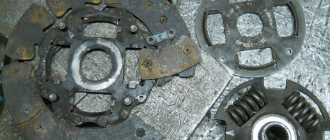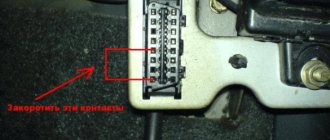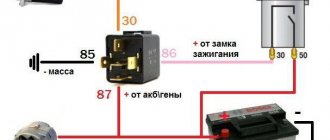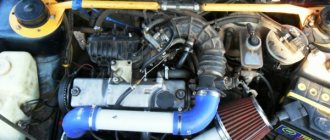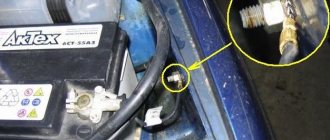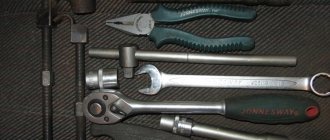The 2111 engine is conventionally considered “native” for the VAZ 2114, since it has been installed for 4 years since the creation of the car model. This version of the internal combustion engine has distributed injection and 4 valves and a volume of 1.5 liters. A tuned version of 21114 with a volume of 1.6 liters was also used by increasing the height of the cylinder block.
Drive VAZ 2114
In 2007, the engines were “pulled up” structurally to Euro-4 standards; the “four” was equipped with a 1.6 liter modification 11183 with 8 valves, an electronic gas pedal and an electric throttle, and a polymer receiver instead of aluminum.
Plastic receiver
Since 2009, the VAZ 2114 model has been modernized by its subsidiary Super-Avto CJSC. A 16-valve internal combustion engine 21124 with a volume of 1.6 liters and a power of 89 hp began to be used. With. A year later, the power unit was upgraded again; a modification of the 2126 engine of the same volume of 1.6 liters was used, but with a power of 98 hp. With.
ICE 21126
Characteristics of motors 2114
Since the release of the Lada Samara VAZ-2114, the technical characteristics of the gasoline drive have been constantly improved. Owners of domestic cars, in principle, do not have questions about what kind of oil to pour into the engine, since standard requirements apply for Zhiguli, Lada and Samara - 5W30 or 10W30.
Oil change 2114 with engine flush
In addition, you should know what kind of oil to use in transmission gears - the instructions from the AvtoVAZ manufacturer recommend using the GL-4 group of lubricants with a viscosity of 80W85 (mineral), 75W90T (synthetic) or 85W90 (semi-synthetic).
After filling with synthetics, the box becomes noisy, the oil is more expensive, but the lubricant is mostly imported, which provides additional guarantees. Domestic manufacturers most often produce semi-synthetics of average quality for engines and transmission gearboxes.
The technical characteristics of the engine are as follows:
| Characteristics | Engine modification | ||||||||
| 2111 | 21114 | 11183 | 21124 | 21126 | |||||
| Years of installation | 2003 – 2007 | 2003 – 2007 | 2007 – 2009 | 2009 – 2013 | 2009 – 2013 | ||||
| Volume | 1500 cm3 (1.5 l) | 1596 cm3 (1.6 l) | 1596 cm3 (1.6 l) | 1599 cm3 (1.6 l) | 1597 cm3 (1.6 l) | ||||
| Power | 56.4 kW (77 hp) | 59.5 kW (81.6 hp) | 59.5 kW (82 hp) | 65.5 kW (89.1 hp) | 72 kW (97.9 hp) | ||||
| Torque moment | 115.7 Nm (3200 rpm) | 125 Nm (3000 rpm) | 120 Nm (3200 rpm) | 131 Nm (3700 rpm) | 145 Nm (4000 rpm) | ||||
| Weight | 127.3 kg | 112 kg | 112 kg | 121 kg | 115 kg | ||||
| Compression ratio | 9,8 | 9,6 | 9,6 | 10,3 | 11 | ||||
| Nutrition | injector | ||||||||
| Engine diagram | Inline (L) | ||||||||
| Ignition | module | coil | coil | coil for each spark plug | |||||
| Number of cylinders | 4 | ||||||||
| Location of the first cylinder | TVE | ||||||||
| Number of valves on each cylinder | 2 | 2 | 2 | 4 | 4 | ||||
| Cylinder head material | aluminum alloy | ||||||||
| Intake manifold | aluminum | plastic with receiver | |||||||
| An exhaust manifold | with catalyst | ||||||||
| Camshaft | 2110 | 2111 | 2112 | ||||||
| Cylinder diameter | 82 mm | ||||||||
| Piston stroke | 71 mm | 75.6 mm | |||||||
| Pistons | Yes | No | No | Yes | No | ||||
| Valve bend | Yes | No | No | Yes | No | ||||
| Crankshaft | 2112 | 11183 | |||||||
| Fuel | AI-95 | ||||||||
| Environmental standards | Euro 4 | Euro 2 – 4 | Euro 3 – 4 | ||||||
| Fuel consumption highway/combined cycle/city | 5,7/7,3/10 | 6/7,3/10,4 | 6/7,8/11 | 5/7/9,5 | 5,4/7,2/9,8 | ||||
| Oil consumption per 1000 km | 0,7 | 0,5 | |||||||
| Engine oil for 2114 | 5W-30 and 10W-30 | ||||||||
| Engine oil volume | 4 l | 3.8 l | 3.5 l | 3.6 l | |||||
| Operating temperature | 95° | ||||||||
| Motor life | declared 150,000 km, real 250,000 km | ||||||||
| Adjustment of valves | washers between camshaft cams and tappets | hydraulic pushers | |||||||
| Cooling system | forced, antifreeze/antifreeze | ||||||||
| Coolant quantity | 7.8 l | ||||||||
| water pump | plastic impeller | ||||||||
| Candles for 2114 | A17DVRM, BPR6ES | AU17DVRM, BCPR6ES | |||||||
| Gap between spark plug electrodes | 1.1 mm | ||||||||
| Timing belt | length 698 – 1125 mm depending on attachments | ||||||||
| Cylinder operating order | 1-3-4-2 | ||||||||
| Air filter | Nitto, Knecht, Fram, WIX, Hengst | ||||||||
| Oil filter | Mann W914/2 | ||||||||
| Flywheel | 2110 | ||||||||
| Flywheel mounting bolts | M10x1.25 mm, length 26 mm | ||||||||
| Valve stem seals | code 90913-02090 inlet light code 90913-02088 exhaust dark | ||||||||
| Compression | from 14 bar | ||||||||
| XX speed | 750 – 800 | 800 – 850 | |||||||
| Tightening force of threaded connections | spark plug – 31 – 39 Nm flywheel – 61 – 87 Nm clutch bolt – 54 – 87 Nm bearing cap – 59 Nm (main) and 43 – 53 Nm (rod) cylinder head – four stages 20 Nm, 71 Nm + 90° + 90° | ||||||||
For high-quality maintenance of internal combustion engines, the engine manufacturer issues a manual containing a description of the drive parameters, the frequency of replacing consumables and step-by-step repair operations. The same operating manual recommends the volume of oil in the gearboxes in the engine.
Broken timing belt
Tuning an injector with 8 valves
To increase power from 77 to 96 horsepower of the very first engine of the VAZ-2111 model, you need to do:
- boring valve seats along the inner diameter;
- boring the channel necks for installing duralumin plates and loosening the springs by 1.5 millimeters;
- replacing standard valves with lightweight ones;
- recessing of guide bushings from special brass;
- installation of a split timing gear;
- use of imported valve cotters;
- installation of a narrow-phase shaft.
The tuning shaft has an inlet of 70 degrees and an outlet of 66. Its opening angles are 250 and 246 degrees, respectively. After completing the work, it is necessary to install the engineering firmware and carefully configure the motor parameters. Only in this case, after all sensors are turned on, the engine will start working normally.
It is better to use a split gear on non-plug-in motors. For installation, it is necessary to carry out the work in almost the same way as when replacing the timing belt, that is, apply marks, disassemble the mechanism, and align the crankshaft. After installing the new gear, pay attention to the 4th cylinder. If the valves in it are not open to the maximum, in this case you will need to loosen the outer screws and adjust the camshaft, after which you need to tighten the fasteners.
Engine design features
Initially, the engine of the VAZ-2114 was 8 valve, had a volume of 1.5 liters, complied with Euro-2 standards, and was marked 2111. In 2005, these engines were boosted:
- to increase the volume to 1.6 liters, the block is increased in height by 2.3 mm;
- Several configurations have been created - for Euro-2 version 21114-00, for Euro-3 model 21114-20 and for Euro-4 modification 21114-70;
- The crankshaft, valve system, camshaft correspond to 11183;
- The cylinder head received an enlarged combustion chamber of 5 x 8.1 cm, which increased power.
Combustion chamber of internal combustion engine 21114
An important feature of the 21114 internal combustion engine is phased rather than pairwise-parallel injection, which was used in the original 2111. The attachments have become more compact:
- catalytic collector instead of the neutralizer and exhaust pipe;
- injector ramp instead of the fuel return line.
Catcollector
The modernization also affected other components, for example, a January 7.2 or M7.9.7 controller was used, the ignition module was replaced with a coil with 4 terminals.
At the same time, VAZ-2114 began to be equipped with engines from Kalina 11183, which have some differences from the previous version:
- the shape of the combustion chamber has been improved;
- The generator is secured with a bracket, the tensioner is modernized.
In 2008, the 2114 engine received a new M73 ECU, and in 20011, the M74 “brains” to achieve Euro-4 standards. The control became completely electronic, but for another whole year the designers corrected firmware defects until they created its final version I414DE07.
ECU M74
The next engine, 2114, was installed on the car by a subsidiary of the manufacturer AvtoVAZ, called Super-Auto, in 2009. It was the 16 valve engine 21124 of the “tenth” VAZ family with improved characteristics:
- “high” blue block (197.1 mm);
- injectors pressed into 2–5 main bearing supports, cooling the pistons with oil;
- The groove depth of the holes in the valves is 5.53 mm, which ensures the safety of the valves in the event of a timing belt break; major repairs are not required.
Blue block
The following year, the fourteenth models began to be equipped with 21126 engines from export Priors. After tuning the 21124 engine, the internal combustion engine device differs in the following nuances:
- honed cylinders, gray block;
- crankshaft pulley and timing belt with semicircular tooth;
- the weight of the connecting rod and piston group is reduced;
- there is no friction in the lower head of the connecting rod;
- candle glasses are built into the head.
Piston group 21126
The internal combustion engine uses the principle of hydraulic compensation of valve clearances; the 0.45 mm thick cylinder head gasket is made of multilayer metal. The motor is equipped for Euro-3 with a collector 11194-1203008-10 or Euro-4 with a collector 11194-1203008-00. The service life of the pump has been increased due to a new design of the oil seal and bearing, and changes to the toothed pulley.
Hydraulic compensators
The ignition system has a separate coil for each spark plug. Phased injection, stainless steel fuel rail, January 7.2 or M7.9.7 controllers.
The main mistakes made when tuning
Many people try to add power to the engine, but at the same time make typical mistakes. The leading ones among them are:
- installation of cutters in garage conditions (this work requires high precision);
- use of unnecessary and expensive spare parts;
- lack of suitable firmware for a sports camshaft or other elements.
Before buying expensive spare parts, you should pay attention to the recommendations of the specialists. They created a list of useless components:
- A receiver with an increased volume is good only at medium and high speeds, but for work in the range from 1000 to 2500 rpm, a standard spare part is more preferable.
- A zero filter, called a “chandelier,” is a fairly useful addition, but you will have to constantly clean it with special chemical compounds. This will increase the cost of maintaining the car.
- A throttle valve of increased diameter does not increase power too much, since the engine always has enough air.
Cons and pros
Depending on which 2114 engine is used, the owner’s risks differ:
- 2111, 21183, 21114 and 21124 – do not bend the valve if the timing belt breaks;
- 21126 – valve bending due to insufficient groove.
The main disadvantage of the latest 16 valve versions is the lighter crank mechanism:
- the engine is adjusted to Euro-4 standards;
- to reduce weight, the length of the piston skirt is reduced;
- Accordingly, the width of the oil scraper and compression rings decreases;
- The resource of the internal combustion engine is sharply reduced.
Grooves in the pistons so that the valves do not bend if the belt breaks
For example, in Japan, manufacturers abandoned Euro-4 standards, considering that the reliability and high service life of the motor are more important for the consumer.
The drive power increased from 77 horsepower to 81 hp, then 82 hp, 89 hp, and 98 hp. In models with hydraulic compensators, periodic adjustment of this unit is not required, however, the quality of the oil in the system must be high for normal operation of the pushers.
16 valve engine 1.6 (SuperAuto)
Not everyone knows, but 2114 also has a special SuperAuto series. A small number of these cars were produced. They are distinguished by improved driving performance and dynamic characteristics.
Under the hood of this car there is a 1.6-liter engine with 16 valves. It produces a power of as much as 92 hp , which is quite good for this model. Combined with the light weight of the car, this made it much faster. The car accelerates to 100 km/h in 11.2 seconds.
AI-95 fuel is recommended for this engine. But some drivers use AI-92. For a hundred kilometers, such a car requires approximately 7.2 liters of gasoline.
Maintenance schedule
To avoid having to carry out expensive overhauls of the Lada Samara 2114 yourself, you should follow the manufacturer’s recommendations for servicing the internal combustion engine:
| Maintenance object | Time or mileage (whichever comes first) |
| Timing belt | replacement after 100,000 km |
| Battery | 1 year/20000 |
| Valve clearance | 2 years/20000 |
| Crankcase ventilation | 2 years/20000 |
| Belts that drive attachments | 2 years/20000 |
| Fuel line and tank cap | 2 years/40000 |
| Motor oil | 1 year/10000 |
| Oil filter | 1 year/10000 |
| Air filter | 1 – 2 years/40000 |
| Fuel filter | 4 years/40000 |
| Heating/Cooling Fittings and Hoses | 2 years/40000 |
| Coolant | 2 years/40000 |
| Oxygen sensor | 100000 |
| Spark plug | 1 – 2 years/20000 |
| Exhaust manifold | 1 year |
If consumables are replaced within the recommended time frame, the operational life of the internal combustion engine will increase.
About LADA 2114 engines 1st generation (2001 - 2013)
The VAZ 2114, popularly known as a four, is a popular front-wheel drive five-door hatchback, released to replace the VAZ 2109. The car was released in 2001.
It is a representative of the Samara 2 series, along with the three-door VAZ 2113 and the VAZ 2115 sedan. In fact, the VAZ 2114 is a restyling of the old nine. The appearance has become more modern, and the interior has also been updated. The VAZ 2114 can be called a kind of “people’s” car, since its popularity among the population was enormous. In the article we will look at the engines that were installed on the VAZ 2114, we will touch on their characteristics and disadvantages. The VAZ 2111 engine, which is popularly called 2114, is generally the eighty-third engine. However, unlike 21083, 2114 uses an injector rather than a carburetor. In addition, the 2114 is characterized by the presence of a floating connecting rod pin and a different camshaft. Finally, the 2114 has more power. Engine VAZ 2114 1.5 l. in-line, injection, with four cylinders, has an overhead camshaft, the timing drive uses a belt. In this case, if the belt breaks, the valve slider does not bend.
As for the shortcomings, the following are noted. It is necessary to adjust the valves, parts of the cooling system wear out quickly, frequent replacement of the oil filter is required, problems with the valve cover seal, fuel pump and distributor sensor. The exhaust pipe fastenings may break because steel nuts are used rather than brass.
In addition, the speed often begins to float. The engine may trip. Often the engine does not warm up to the desired operating temperature. The problem is most likely with the thermostat. In addition, the engine may knock and make noise, usually due to unadjusted valves.
Engine 21114, which has a second index of 11183, is a development of the ideas laid down by the 2111 1.5 liter power unit. and directly, 083 motor. The engine has a taller cylinder block, increased piston stroke, and a volume of 1.6 liters. The engine has improved environmental performance and greater reliability.
Compared to VAZ 2111 engines, the VAZ 11183 unit is less capricious, more elastic and high-torque. If we compare these two engines, it should be noted that although they are assembled at the same plant, they are assembled on different lines. This is an in-line injection engine with four cylinders and an overhead camshaft. The timing drive uses a belt. If it breaks, the engine does not bend the valve, but if you have a bad sports camshaft, the risk of a problematic outcome is possible.
The engine has the following weaknesses. The need to timely adjust the valves. The engine can be noisy and diesel, in general it should be noted that the engine is quite noisy, various extraneous sounds and knocks are normal for it. Finally, the engine is characterized by tripping, overheating, or, on the contrary, problems with warming up to operating condition.
AvtoVAZ, as part of the development of 16 valve engines, in 2004 replaced the VAZ 2112 engine with a 124 power unit. A higher block from Kalina was used on it, the piston stroke was also increased, obtaining a working volume of 1.6 liters. By adapting the 124 engine to Euro-3 standards, its environmental performance was increased. In addition, there is now traction at the bottom, and quieter engine operation is noted.
Engine 21124 1.6 liters is an in-line engine of injection type with four cylinders and has an overhead camshaft. The timing drive uses a belt. If it breaks, the engine does not bend the valve, thanks to special holes. According to official data, engine 21124 has a service life of 150 thousand km, while in practice it reaches 200-250 thousand km.
First of all, it is necessary to note the requirement to regularly tighten the timing belt. In addition, the engine is characterized by shaking, knocking and noise during operation. The engine is also susceptible to overheating. Despite these shortcomings, according to owner reviews, the VAZ 21124 engine can be called one of the best power units from VAZ.
The 21126 engine is a continuation of the VAZ 21124 power unit, which has a 39% lighter ShPG from Federal Mogul. This is an engine with reduced valve holes and a timing belt with an automatic tensioner. Due to this, the problem of timely belt tension disappeared.
In terms of the block, we have higher quality surface treatment and high requirements for honing cylinders to Federal Mogul standards. VAZ 21126 1.6 l. It is an in-line injection engine, it has four cylinders and overhead camshafts. In general, the engine is considered quite good, especially for the city.
Owners note uneven operation and loss of engine power. In addition, the timing belt is not particularly reliable. Uneven operation of the engine can be caused by problems with fuel pressure, timing problems, faulty sensors, air leaks through hoses, or a malfunction of the throttle valve. In case of loss of power, the reason must be sought in low cylinder compression, wear of cylinders, piston rings, and burnout of pistons. If the timing belt breaks, the engine may bend the valves. The problem is solved by replacing the standard pistons with weldless ones.
Source
Typical breakdowns
The very first 1.5 liter engine 2114 has disadvantages:
- periodic valve adjustment;
- unreliable injection system;
- loosening the exhaust manifold nuts;
- Leaking gaskets of the fuel pump, distribution sensor of the ignition system.
The next 1.6 liter engine does not cause any particular problems for the owner, with the exception of high vibration and noise loads. The weak point traditionally remains the valves, which have to be constantly adjusted.
Adjustment of valves
The internal combustion engine from Lada Kalina 11183 was installed on the fourteenth model solely to meet Euro-3 standards. It has typical disadvantages for a linear series and is no different.
The first sixteen-valve engine 21124 does not bend the valves, the gaps in which are adjusted by hydraulic pushers. However, the belt needs to be tightened after 15,000 km due to the large number of attachments. The second and last in the line of fourteenth ICE models, ICE 21126, has increased power. In addition to typical malfunctions, if the timing belt breaks, the piston will bend the valve due to insufficient recess depth.
Frequent internal combustion engine malfunctions
Let us immediately note that the design of the VAZ 2114 and the engines in particular on this model may have a number of differences. Early versions are simpler, while in the latest modifications the unit received more complex electronic equipment, ECM sensors, etc.
One way or another, most of the problems that the 2114 engine can present:
• the “check” light is on, the speed fluctuates; • the motor does not develop power; • the power unit stalls, stalls or does not start; • extraneous noises and knocks appeared in the engine;
As with any other fuel-injected internal combustion engine, it is necessary to perform engine diagnostics, since there are many possible reasons why failures occur.
For example, the failure of one of the ECM sensors may result in the ECU receiving incorrect data and the controller going into emergency mode. You also need to pay attention to timing, valve adjustment, etc.
If we consider the VAZ 2114 engine itself, its repair is not very different from the repair of the VAZ 2108 engine. In turn, this allows experienced car owners to repair the specified internal combustion engine with their own hands.
